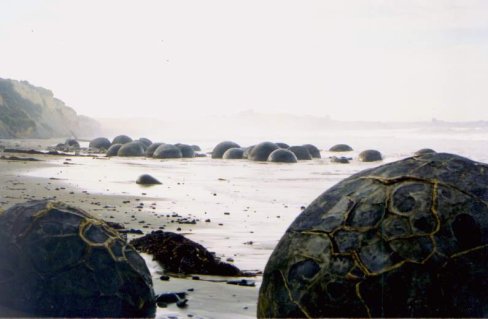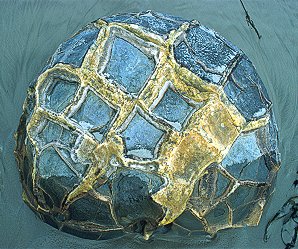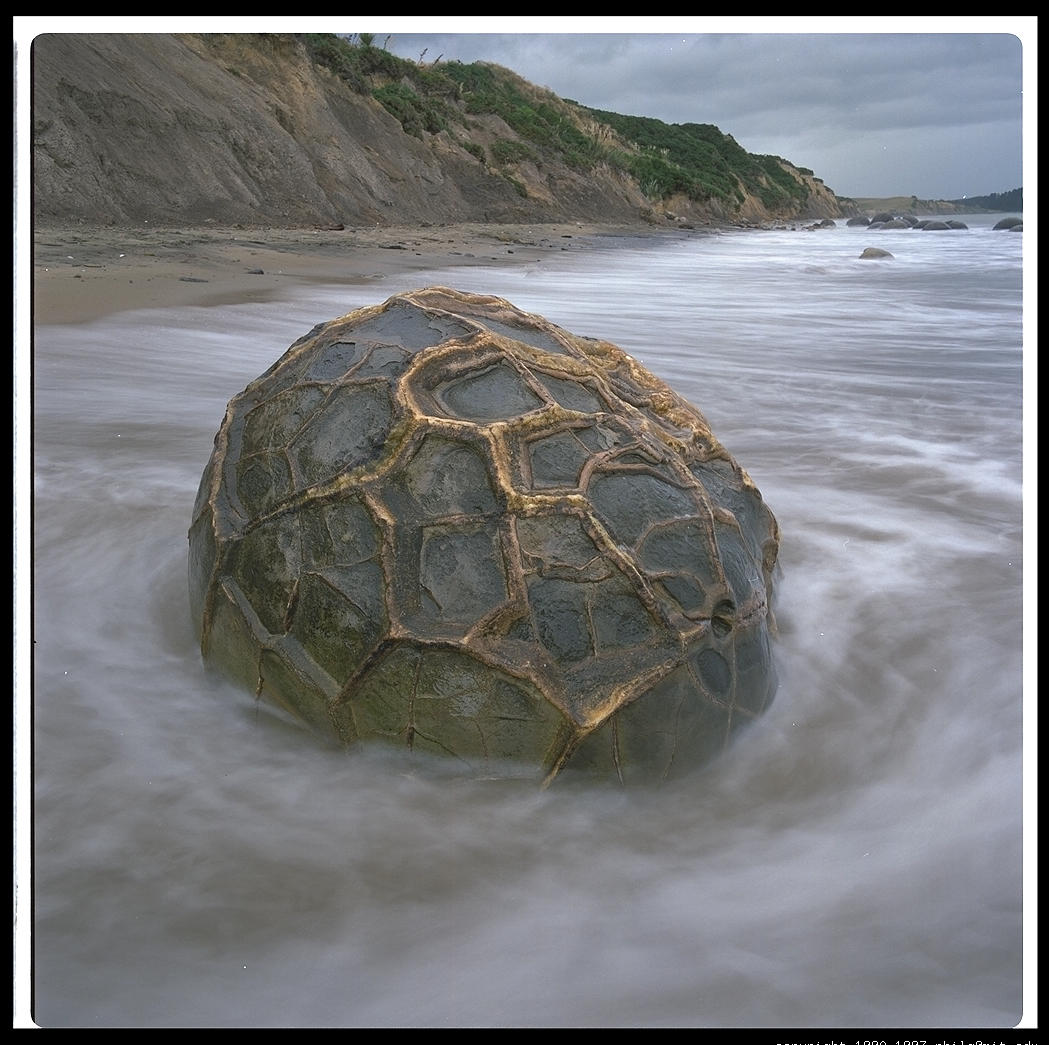A little fishing village on the coast south of Oamaru has become famous for a geological wonder on its windswept sands.
These large, spherical, alien and strangely beautiful boulders are mainly located on Koekohe Beach, part of the Otago coast of New Zealand’s South Island. Known as “Moeraki Boulders” they were originally formed on the sea floor from sedimentary deposits that accreted around a core in the same way that a pearl will form around a particle of sand. The erosion of the cliffs often reveals these boulders from the surrounding mudstone allowing them to join those already on the beach. Some of the larger boulders weigh several tonnes and can be up to three metres wide.
Maori legend attributes their origin to the arrival of the first ancestors / giants who came in the great Araiteuru canoe which was sunk by three great waves at nearby Matakaea.
The Moeraki Boulders are huge spherical stones that are scattered over the sandy beaches, but they are not like ordinary round boulders that have been shaped by rivers and pounding seas. These boulders are classed as septarian concretions, and were formed in ancient sea floor sediments. They were created by a process similar to the formation of oyster pearls, where layers of material cover a central nucleus or core. For the oyster, this core is an irritating grain of sand. For the boulders, it was a fossil shell, bone fragment, or piece of wood. Lime minerals in the sea accumulated on the core over time, and the concretion grew into perfectly spherical shapes up to three metres in diameter.
The original mudstone seabed has since been uplifted to form coastal cliffs. Erosion of the cliffs has released the three tonne captive boulders, which now lie in a haphazard jumble across the beach. Further erosion in the atmosphere has exposed a network of veins, which gives the boulders the appearance of turtle shells. Similar boulders occur at Shag Point, and the nearby swimming beach of Katiki. In Hawke’s Bay in the North Island, scientists have found that the central core of similar boulders contained perfectly preserved skeletons of turtles, sea snails and extinct reptiles, such as plesiosaurs.
Moeraki has a long history of Maori occupation, which is represented in the town today by the Kotahitanga Maori Church and a pa site nearby. This small seaport town was the first European settlement in North Otago. Behind the town a road leads to the lighthouse where you can find a yellow-eyed penguin sanctuary and a seal colony. There are other walks of ecological interest around the coast, and through the Trotter’s Gorge native forest. South of Moeraki is the town of Palmerston, where you can follow an historical scenic route to Central Otago.
Moeraki makes a fascinating stopover point, both for the dramatic coastal scenery and the curious geological phenomenon on the beaches.
It is said by the Maoris that some of the surviving crew of the Araiteuru canoe were turned into stone and became mountains. The Moeraki boulders are said to be the pots and chattels from the canoe.















These large, spherical, alien and strangely beautiful boulders are mainly located on Koekohe Beach, part of the Otago coast of New Zealand’s South Island. Known as “Moeraki Boulders” they were originally formed on the sea floor from sedimentary deposits that accreted around a core in the same way that a pearl will form around a particle of sand. The erosion of the cliffs often reveals these boulders from the surrounding mudstone allowing them to join those already on the beach. Some of the larger boulders weigh several tonnes and can be up to three metres wide.
Maori legend attributes their origin to the arrival of the first ancestors / giants who came in the great Araiteuru canoe which was sunk by three great waves at nearby Matakaea.
The Moeraki Boulders are huge spherical stones that are scattered over the sandy beaches, but they are not like ordinary round boulders that have been shaped by rivers and pounding seas. These boulders are classed as septarian concretions, and were formed in ancient sea floor sediments. They were created by a process similar to the formation of oyster pearls, where layers of material cover a central nucleus or core. For the oyster, this core is an irritating grain of sand. For the boulders, it was a fossil shell, bone fragment, or piece of wood. Lime minerals in the sea accumulated on the core over time, and the concretion grew into perfectly spherical shapes up to three metres in diameter.
The original mudstone seabed has since been uplifted to form coastal cliffs. Erosion of the cliffs has released the three tonne captive boulders, which now lie in a haphazard jumble across the beach. Further erosion in the atmosphere has exposed a network of veins, which gives the boulders the appearance of turtle shells. Similar boulders occur at Shag Point, and the nearby swimming beach of Katiki. In Hawke’s Bay in the North Island, scientists have found that the central core of similar boulders contained perfectly preserved skeletons of turtles, sea snails and extinct reptiles, such as plesiosaurs.
Moeraki has a long history of Maori occupation, which is represented in the town today by the Kotahitanga Maori Church and a pa site nearby. This small seaport town was the first European settlement in North Otago. Behind the town a road leads to the lighthouse where you can find a yellow-eyed penguin sanctuary and a seal colony. There are other walks of ecological interest around the coast, and through the Trotter’s Gorge native forest. South of Moeraki is the town of Palmerston, where you can follow an historical scenic route to Central Otago.
Moeraki makes a fascinating stopover point, both for the dramatic coastal scenery and the curious geological phenomenon on the beaches.
It is said by the Maoris that some of the surviving crew of the Araiteuru canoe were turned into stone and became mountains. The Moeraki boulders are said to be the pots and chattels from the canoe.


























0 comments:
Post a Comment